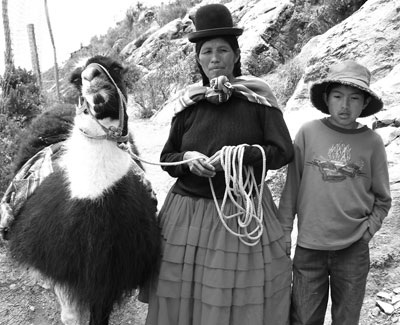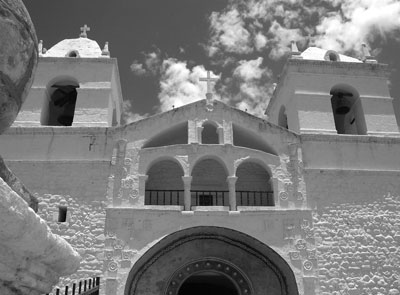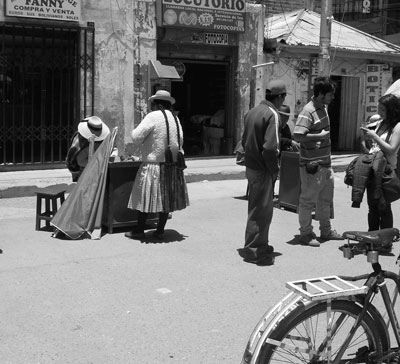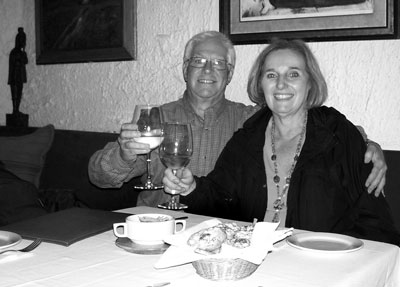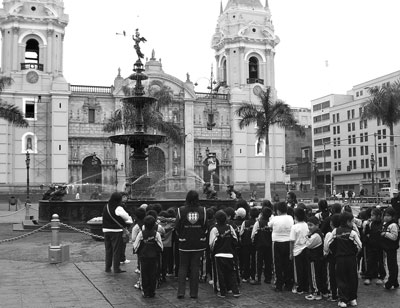Peru and Bolivia — Encountering good food, friendly locals, amazing archaeological ruins and a few bumps along the way
by Marvin Herman & Judy Licata, Delavan, WI
Deciding on a travel destination where the buying power of the dollar is in your favor, the people genuinely like visitors from the US and there is minimal time difference, reducing jet lag, is easier than one might imagine. Think South America. And one of the countries on that continent that has a large population of indigenous people plus a compelling history, reflected in its major physical attractions, is Peru.
Making plans
My wife, Judy, and I spent a fascinating 23 days in October-November ’08 in Peru, particularly in Lima and points south, including an exciting 3-night side trip to Bolivia. With the exception of train tickets and bus reservations, where we had to sometimes use the telephone, our entire trip was planned and booked via the Internet for about $3,700 each, including round-trip airfare from Chicago.
Other planning resources included Lonely Planet’s “Guide to Peru” and Eyewitness Travel’s “Peru,” both of which we brought with us. We used TripAdvisor.com to help us choose accommodations, and the online recommendations proved to be reliable.
We prepared an itinerary filled with ruins and archaeological sites, interests in which we immersed ourselves in the months before the journey. We did book some sections of the trip with local tour operators.
As we left the US we felt fully prepared. The only open question was in regard to some bus transportation, but we felt we could straighten that out when we reached Lima. (We could not obtain our tickets unless we actually signed a credit card slip.)
For insurance, we bought a foreign travel rider from our Medicare supplement company for about $5 each ($250 deductible) and a “basic repatriation of remains” package from Divers Alert Network (800/446-2671, www.diversalert
network.org) at $40 for both of us. We are basically in good health and saw no reason to purchase expensive insurance packages such as those sold to package-tour customers.
We were aware of and had experience with altitude sickness on other trips, so we planned a gradual ascent to the Andes. We noted that some package tours needing to cover a lot of ground in a short amount of time simply fly travelers to Cuzco (14,000 feet), but we would use buses and trains, as I felt certain that a substantial percentage of people flying directly into Cuzco and visiting Machu Picchu the next day would have difficulty with the altitude and fail to enjoy their experience to the fullest. I hoped that would not be a problem for us.
Lima
Due to long lines at Peruvian Immigration, our bags were sitting next to the carousel when we got to baggage claim. After obtaining some nuevos soles (about three to one US dollar) from the airport ATM, we were met by the prearranged driver, who took us to the San Antonio Abad Hotel (Av. Ramón Ribeyro 301; www.hotelsanantonioabad.com) in Miraflores.
Our room was larger than I expected for $50 per night, including a hot breakfast. The water was hot, the room clean and the staff helpful and friendly.
We decided to self-tour downtown Lima, so our hotel arranged to have a taxi driver take us to the Plaza de Armas. He would return four hours later to pick us up in front of the Gran Hotel Bolivar. For this he charged us 40 soles ($13) and expected no tip.
We made a quick visit to the cathedral, walked to the fountain in the plaza and strolled the busy shopping area. Later we requested to be dropped off at the seafront tourist area known as Larcomar, which had chain restaurants, an upscale movie theater, high-end alpaca sweater stores, craft boutiques and optical shops. (Lima seems to be the world headquarters for eyeglasses shops.)
Judy, needing new glasses and having her prescription with her, visited Lentes & Lentes and ordered glasses, which, we were told, would be ready the next afternoon. After a few stops along the avenida, we headed back to the hotel on foot.
That evening we dined at Trattoria Don Vito, a cozy Italian restaurant just behind the hotel. With a bottle of chilled Peruvian white, we started with cheesy, warm bread and a tasty jardinière. Including our pasta dishes and a shared dessert, the bill came to around 100 soles ($33).
In the morning, following a tour (arranged through our hotel) of Pachacamac, a ruin of interest outside of Lima, Judy and I explored the Indian craft area of Miraflores. Later we walked back to the optical store and picked up her glasses, which were perfect and cost about $50 — a fraction of what they would have cost at home.
We noted that in Lima the sun almost never shined. We were told it comes out only in the summer months of December, January and February.
On to Nazca
Following a brief stay in Ica at Las Dumas, a beautiful resort with extensive grounds, we headed by bus to Nazca, where we planned to see the Nazca Lines and visit the Cementerio de Chauchilla, an ancient burial ground. Also on our itinerary was a stop at a newly discovered pyramid in Cahuachi, which some say may be the largest in the world.
After two hours of driving through hazy desert air, we arrived in town, which appeared to have as its sole economic support the Nazca Lines.
No one from our reserved accommodation, the Alegría Hotel, was at the station to greet us, but we soon discovered why: the hotel was only about 75 yards from the bus station.
After checking in, we went next door to the office of Alegría Tours, where we booked three tours for the next day. The total cost was $190, $140 of which was for the small plane that would take us above the famous, mysterious lines.
We gave ourselves a tour of the town, then returned to the hotel for dinner, enjoying bowls of delicious soup of the region and lomo saltado, slices of beef and fried potatoes with rice in a mushroom sauce. The total cost was $20.
Having slept well, notwithstanding the noise from the restaurant, traffic, crowing roosters and music, we were collected by our tour group for the ride to the airport, five minutes out of town. After paying another $7 each for airport tax, we waited 1½ hours for a plane.
Each plane carries a pilot and three passengers. I sat up front with Miguel, the pilot. After another delay on the tarmac, we roared down the runway and into the sky.
Soon we were able to recognize some of the linear formations we had seen in photos: the monkey, the hummingbird and geometric shapes. During our flight, we hit an air pocket and the plane dropped suddenly, but our landing was smooth.
After lunch at the hotel, we met Orlando, our guide for the afternoon, who was very knowledgeable about local archaeology.
He first drove us to the Cementerio de Chauchilla, where we saw burial sites with corpses and bones over 1,000 years old, uncovered and preserved in the midst of a forbidding desert just outside the town. Next we headed to Cahuachi, in the center of a moonscape about 15 miles outside of Nazca. It is the site of a newly discovered pyramid complex.
It was fascinating to walk up the side of the hill knowing that beneath us was the roof of a building, then to look across the hills to see the building it connected with.
Orlando spoke English well and answered all our questions.
That night we rolled our luggage across the street to the bus station, where our bus was set to leave for Arequipa at 10:30 p.m.
Upon our arrival in Arequipa, we got a cab (6 soles) to the Casa Andina Classic Arequipa (www.casa-andina.com) on Calle Jerusalén. We were at an altitude of about 8,000 feet, but we were not bothered by it, having started our Diamox days before. By 10 a.m. we were ready to hit the streets.
Our goals were to visit Juanita, the Ice Princess, a very well-preserved mummy housed at Museo Santuarios Andinos, and see the Monasterio de Santa Catalina.
We walked to the Monasterio de Santa Catalina, a 16th-century convent to which aristocratic Spanish families gave their second daughters in service to God. The girls had servants and slaves and lived in lavish quarters until the Pope called an end to it in the 19th century.
We strolled the streets and courtyards of the monasterio for over an hour.
A few doors down we found the Museo Santarios and learned about Juanita, the Ice Princess, whose frozen corpse was found on a mountaintop in 1995, having been there since the 1400s. There was an introductory 20-minute film, then a docent gave us a nice 40-minute tour, including a view of Juanita, still frozen in her temperature-controlled case.
Things take a turn
During our two days in Colca Canyon, where we had hoped to see some condors (unfortunately, we did not), Judy started to feel ill. I suspected altitude sickness.
We continued by car to Arequipa, arriving at Hostal Tambo Viejo in the late afternoon. Our room there was clean but a bit shabby ($35).
The hotel was left in the charge of a young girl of about 17 who spoke no English. We were hungry, so she showed us a menu, from which we selected a pizza. After a few bites, Judy became sick. I asked for a bottle of water, but it was an impossibility since the girl had not been left the key to the drink cabinet, so I went out to buy some. Judy was asleep when I returned to our room.
We were to leave the next day for Puno, another increase in altitude. Unless Judy could rally, we might be in for some trouble.
On arriving in Puno, we asked a taxi driver to take us to the train station to pick up our tickets for the ride from Puno to Cuzco, which we had booked on the Internet and paid for with a wire transfer since PeruRail did not take credit cards. (They do now.) It was important for us to get to Cuzco since it was from there that we planned to travel to Machu Picchu and the Sacred Valley, also by train.
The agent had a copy of our funds transfer and I showed him our passports and e-mails from PeruRail, but he told me that he could not issue the tickets since there was a civilian strike against the trains in the area and the tracks were being blocked. I was told that if he issued the tickets and the train did not run, I would not be able to claim a refund, whereas if he kept the tickets we could come to get them later if the strike lifted.
I told him we were going to Bolivia the next day and that we might not be back in time to pick up the tickets. He said the chances of the train’s leaving were slim, and he handed me a sheet of paper with instructions for obtaining a refund.
On checking into Casa Andina Puno Classic, we asked for a doctor for Judy. A female doctor and a male pharmacist came to the room and treated her for almost two hours, administering an injection and a great quantity of oral medication.
The diagnosis was a stomach infection, the result of food poisoning. She also received oxygen to help with any altitude issues. The cost of all this was only $70.
I am well aware that independent travel is about meeting challenges, and we had done that as best we could, but at this point I was running on empty. Needing a success, I was happy when I finally got in touch with a representative of Edgar Adventures (www.edgaradventures.com), who had arranged our upcoming three days in Bolivia.
I was introduced to Edgar, himself, who understood my wife was ill and said that he would tailor our Bolivia journey to suit her condition, with an easy schedule the next day. We had already paid for this portion of our trip with a wire transfer ($1,270 for both of us for the three days).
Back at the hotel, Judy was sleeping. I requested a wakeup call for 7:00, then fell asleep before 10 p.m. What a day!
Bolivia
In the morning we were met by Delfina, a representative of Crillon Tours, the company to which Edgar subcontracted our Bolivia trip. She would be taking us to the border in Desaguadero, where we would cross into Bolivia.
Upon our reaching Desaguadero, a filthy border town with garbage-strewn streets, Delfina walked us through Peruvian Immigration, where we gave up our visas. Then we crossed to the Bolivian Immigration building and were asked for our passports.
Suddenly, everything was wrong. We had to redo our paperwork and pay $135 each to get our visas, the officer holding each bill up to the light and checking for the slightest tear. When we told him we did not have the requested yellow fever certificate (we had not been told we needed one and had no plans to visit the jungle), he refused to issue the visas.
After much arguing, our Bolivia guide, Guido, arrived none too soon. He made a quick call to his office and we were finally on our way.
We headed south toward El Alto, a dusty Bolivian city, then continued toward Tihuanaco, a ruined city from 2000 BC. After a couple of hours, we stopped for lunch. I had chicken quinoa soup and lake trout from Titicaca. Judy, being kind to her stomach, had only the soup and some rice and potatoes.
Shortly after lunch we reached the ruin. Tiahuanaco was a special treat for Judy and the main reason we were in Bolivia.
Then it was two more hours of driving, back toward Lake Titicaca, to reach the upscale Inca Utama Hotel & Spa, owned by Crillon Tours. We checked into our nice room with its stunning view of the lake.
After a morning tour and a break for lunch, we met Guido for our next adventure. First, we saw a film about the Kallawayas, the mystical healers of the Andes, then we visited a museum with an exhibition of many of the healing methods used. At the end of the museum tour we met Tata Benjo, a Kallawaya, who blessed us and our families and prayed for our safety for the rest of our journey.
Next we headed to the Altiplano Museum on the premises of our hotel in Huatajata, which had done a lot to pull together our visit to Bolivia. Before 9:30 we were loaded into a large hydrofoil and were joined by a dozen German tourists and their guide.
For the next two nights we would be staying at Posada del Inca Eco-Lodge, another Crillon hotel, on Sun Island. To reach the hotel, we took the easier but longer route, a half-mile path that climbed 300 feet to the base of a tower, continuing as a flatter path to the hotel. Judy rode a mule employed by the hotel for most of the way and her carry-on bag was toted up for her.
The Germans took the “short” way, and we were into our second cup of coca tea as they arrived.
From the hotel grounds, the views of the lake were magnificent, framed by the terraced hills of the island. It was one of the most paradisiacal places we have stayed in our travels.
After a relaxing time on Sun Island, I was anxious to get to Puno to find out about our train. Passing through Bolivian Immigration, we were turned over to Leisl, a very capable guide who saw us through Immigration and into Peru.
We immediately acquainted her with our train issue and she made a call. The train to Cuzco was running normally! We arrived at the station to pick up our tickets with only 10 minutes to spare.
Luxury rail
In the morning we boarded Coach A of the Andean Explorer, which, we were told, is owned and operated by Orient-Express (not to be confused with Venice Simplon-Orient-Express). At $163 each, including the cost of the wire transfer, it was a splurge.
We leaned back, relaxed and enjoyed the scenery on the 10-hour trip to Cuzco. We ordered a pot of café con leche, which was served to our cloth-covered table in china cups, then headed to the observation car as we passed through a huge Wednesday market.
At last we arrived in Cuzco, taking a taxi to Casa Andina Classic Catedral, just off the Plaza de Armas.
Our first priority the next day was to get our train tickets for Machu Picchu at the Cuzco train station. Like our other train tickets, these had been paid for in advance by wire transfer, although I noticed that other waiting travelers seemed to have no trouble securing train tickets to the site of this major tourist attraction without advance purchase.
Strolling the city, we walked to the Inca Museum (aka the Archaeological Museum of Cusco), a wonderful place that tied together the cultural information to which we had been exposed on this journey. The museum had a scale model of Machu Picchu, the next day’s destination.
For dinner we happened upon a small restaurant on Calle Triunfo, Nuna Raymi, where we enjoyed a bottle of Chilean cabernet and an unbelievable dinner for $33. We promised to dine there again on our return in a few days.
Aguas Calientes
Our wakeup call came at 4:30 so we could catch the 6:05 Vistadome train to Aguas Calientes. The train trip took just under four hours.
The train was not nearly as luxurious as the Andean Explorer, but it had windows on the sides of the roof so we could see a panorama of the scenery as it went by, including the mountaintops. It was unbelievably beautiful.
Arriving at Aguas Calientes, we expected to be met at the station, but no one from our hotel was there to greet us. We asked directions to the Apu Majestic and discovered that it was less than 100 yards from the station.
We knocked on the locked door and were greeted by Ruth, who did not speak English. We registered and paid the $40 rate.
We were told that the bus to Machu Picchu ran each half hour but found that it actually ran whenever it filled up ($14 each, round trip).
It was a half-hour scenic — and sometimes harrowing — ride to the ruins. We bought entry tickets ($36 each) and spent the next five hours scrambling about the structures with the other 3,000 visitors, self touring with the aid of our guidebooks.
Back in Aguas Calientes, we went to dinner at Indio Feliz (Lloque Yupanqui 4-12), which had received good marks from the guidebooks. I had a big glass of Peruvian white wine to wash down a wonderful Creole soup, thick with cheese, onions and leeks.
For a main course, I had a huge portion of trout served with homemade potato chips, sweet potato, and tomato stuffed with pesto. Judy had a nice pasta. With desserts of orange pie and sorbet, the total cost was $35.
We chose not to return to Machu Picchu the next day, instead strolling around the town until we had to catch our afternoon train to Ollantaytambo.
We had enjoyed our hotel, as it was very near the train station and in the thick of the action of the town. Saying good-bye to Ruth, we walked to the train station, where we were told we couldn’t take all our luggage on the train since there was no room for it to be stowed. I became infuriated at the PeruRail personnel, as no one warned us of this. I soon discovered what they actually wanted was money for overweight luggage, which we agreed to pay.
At the train station, Jorge picked us up and took us to our next destination, the hotel complex Kuychi Rumi in Urubamba ($120 per night). He provided transport while we were at this accommodation and we made all arrangements for his compensation through Rodrigo, the owner/manager of this beautiful place.
Knowing that we would have our own self-cater house at Kuychi Rumi, we stopped at a mini-mart to buy wine and other provisions ($58).
Rodrigo’s mother, Claudia, directed us to Villa No. 2, got us a boom box for music and brought us a breakfast kit ($33) before leaving. Fresh bread came each morning at 6:00, left hanging on the door.
We made arrangements with Jorge to pick us up in the morning and take us to the big Sunday market at Písac. It was a special holiday, so we also stopped at the local church, where the service was given in an ancient language. A group of young men stood out front blowing conch shells to conjure the spirits.
Jorge then drove us to the Písac ruins, where we spent two hours enjoying the archaeological wonders and terraced hillsides.
Jorge arrived the next afternoon to drive us to the Ollantaytambo ruin. It was smaller than Písac and we saw it all in 1½ hours. The ticket to see these lesser ruins cost about $12.
After we paid our final bill for Jorge’s services ($75), we were driven back to Cuzco, where we returned to Casa Andina Classic Catedral ($62).
Winding down
We were up early to pack for our 9:30 flight to Lima, where we had booked a room at Hotel Victor ($45), since our flight home was scheduled to leave just after midnight. Arriving in Lima, we were met by a man from the hotel ($10 each way for rides from and to the airport).
Once at the hotel, we took a taxi to the Larco Museum (Av. Bolívar 1515, museolarco.org), housed in an 18th-century mansion built over a pyramid dating back to the seventh century. It contains over 40,000 pieces of pre-Columbian art dating from 7000 BC. There was also an impressive storage area open to the public containing the part of the collection not included in the museum display plus a separate section for erotic art pieces.
After our visit, we ate lunch at the delightful outdoor café on the premises. Returning to the Victor to rest while awaiting our flight, we found that our room did not have much hot water, the lights were too dim for reading and the cable TV had some flickering issues, though it did have plenty of barking dogs nearby.
I checked our flight to Houston on the Internet and found that it was delayed three hours. We would miss our connecting flight to Chicago, but we were thankful that we had a place to relax other than the airport.
We arrived at the boarding gate glad to be going home but happy to have had an exciting and challenging yet fulfilling journey to Peru and Bolivia.


